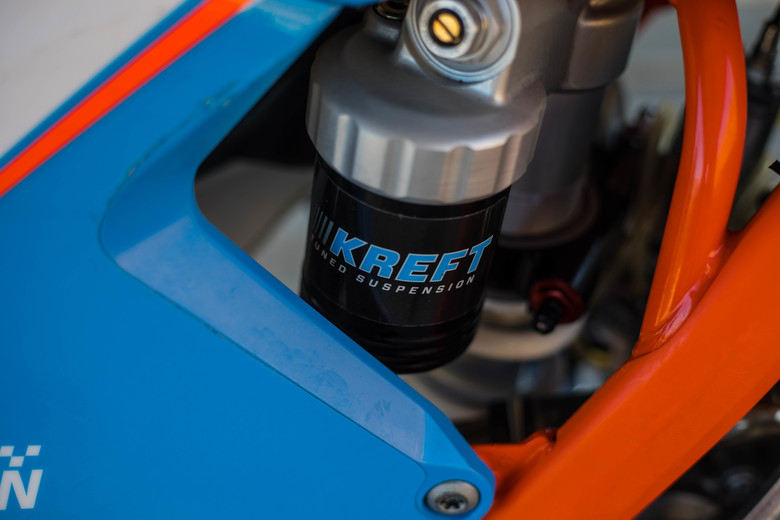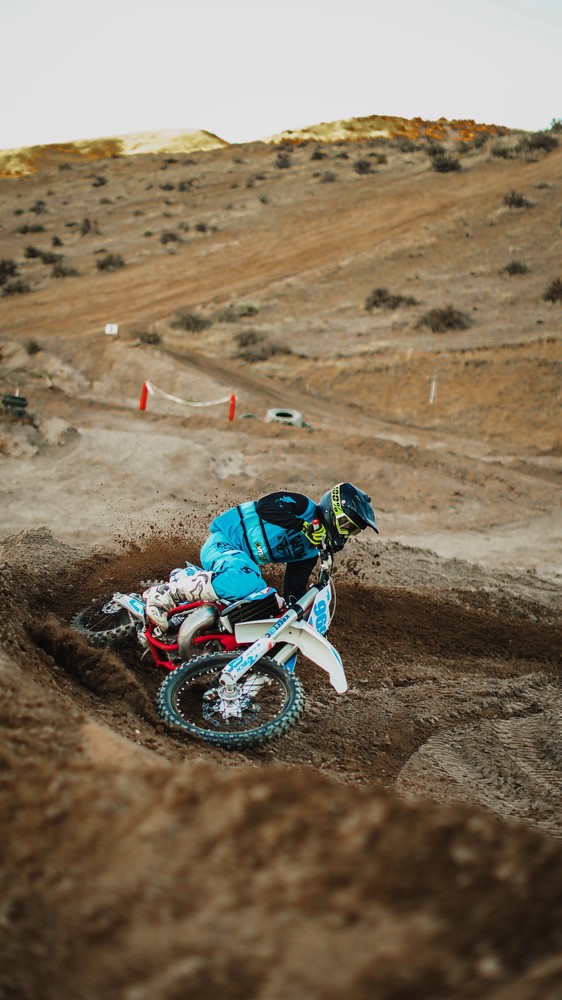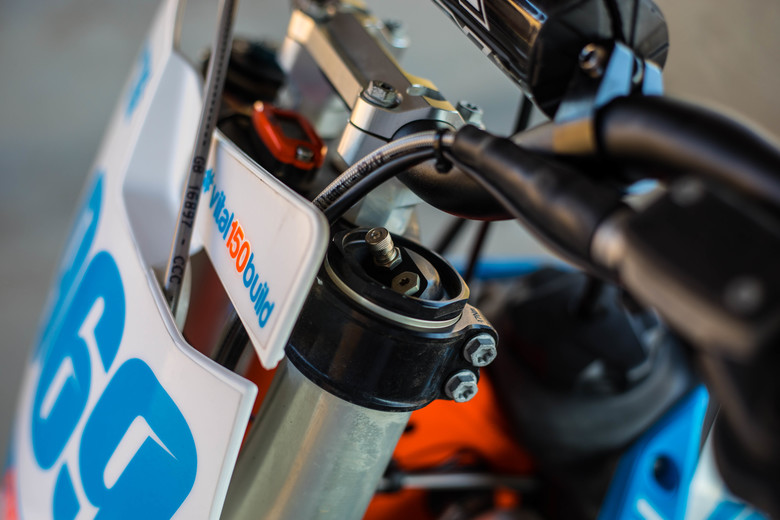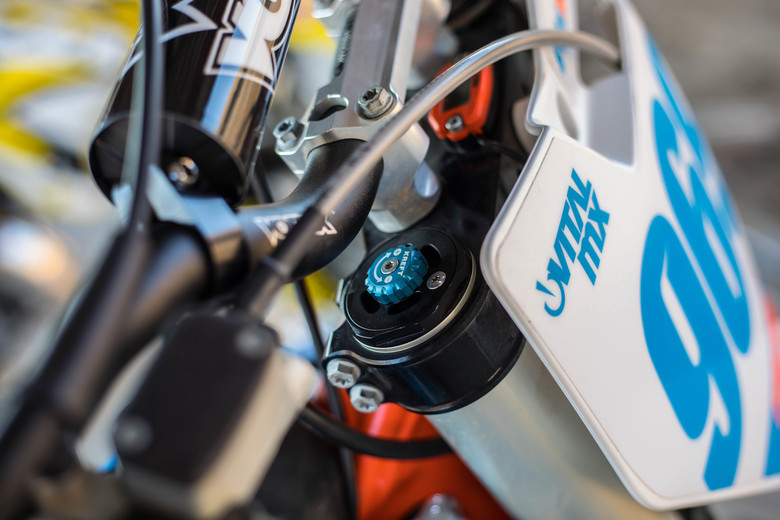I feel that I’m a perfect “everyday rider” to try out the latest and greatest in Air Fork suspension for my KTM 150 SX. To start, I’ve had the opportunity to ride A-Kit suspension back to back from the likes of Ohlins, Showa, KYB and WP and I have personally owned a handful of stock suspensions setups ranging from the amazing SSS suspension as well as perhaps the worst suspension I’ve experienced, the stock 4CS fork on a KTM 250 SX-F. Don’t get me wrong, the KTM AER 48 forks on my 2018 KTM 150 SX are not bad out of the box. In fact they share quite a few of my favorite attributes of the SSS stock fork/shock as well. There are still some differences that may be attributed to them being air forks, so I was eager to find out what Kreft could do to my fork and shock. In all honesty I hadn’t even heard of Kreft Suspension prior to this product testing opportunity and in retrospect I’m so glad that I now know who they are! Read on to see why...


Kreft Revalve Control Suspension:
- $975 AER 48 Revalve Control System
- $70 SKF Seal Kit 48mm WP
- $150 Diamond Microfinish and High Speed Polish - Fork Tubes
- $275 Shock Revalve
- $45 WP 50mm Shock Seal Head Rebuild Kit
- $50 Diamond Microfinish & High Speed Polisch - Shock Shaft
- $190 Xtrig Preload Adjuster - 2016 Link
- $44 KYB 01M & K2C Suspension Fluids - Per Liter
- $64.99 Power Dial Orange
TOTAL $1863.99
First Impressions
Kreft made it so easy to ship off my suspension parts in a box that they mailed directly to my house with padding and spots for each component. I just took off my stock stuff and shipped it out! When the box came back in less than a week, it had a welcome folder on top of the package once I opened it up that went over all that was done, how to use the settings and adjustments and some best practices as well. The components that were swapped out on the outside of the suspension made the set-up look factory and separated it from the stock looking suspension I had previously. The guys over at Kreft were easy to call and talk over any questions I had about the Revalve feature and how they’re stuff differed from the rest. Aside from the look and experience initially, all that needed to be done was to get out on the dirt.


Tech Adjustments
You’ll notice the adjustments might look somewhat unique on the Kreft setup so I’ll briefly cover what each adjustment does. There is compression adjustment dial, blue anodized, on the upper right fork tube just like you may find on the stock AER fork. Kreft provides an easy to navigate “how to” adjust your suspension guide book with your setup and it will walk you through suggested setting changes depending on the terrain and feel you’re aiming to accomplish. The air pressure valve remains on the top of the left fork tube just as you’d expect on the stock AER fork as well.
On the bottom of the right fork tube is where things are a bit more unique. There is a red anodized dial adjuster with a flat head adjustment valve in the middle. The outside adjustment is the Revalve Control (similar to being able to adjust the spring rate) for the fork and this is very handy depending on the track and conditions as it gives you that extra adjustment to allow the fork action to really work best in it’s ideal range. The flat head adjustment inside of the Revalve Adjuster is the Rebound adjuster which has a similar effect as what you would find on a stock fork rebound adjuster. The rear shock comes fitted with the Xtrig sag adjuster making it easy to adjust your sag on the fly and the rear shock high speed & low speed compression and rebound work as they would on the stock shock even with the Kreft internal work done.


Install
The suspension went right back on the same way it came off. Most all the alterations made to the suspension was on the inside so install was pretty straight forward and didn’t require any unique tricks or techniques outside of following my KTM manual.
On the Track
If you’ve followed my experience with the KTM 150 SX thus far you’ll know that the stock suspension set-up was fairly decent. This has been my experience in most of the stock bikes I’ve owned and I’ve never been fully convinced that getting my suspension done by a company was worth the money. I was skeptical that this would be any different. Boy was I wrong. The first ride I took with the Kreft suspension work was out in the mountains on some single track and there were a few things that stood out to me right off the bat.
The first was that the wallowy feeling that came on the stock fork was gone. When I say wallowy feeling, I mean, though the stock forks worked well, the stroke was not as consistent as it could have been. Through chop or even tight rollers or rhythm sections the fork would feel overworked and more movement through the stroke up and down would be taking place than probably necessary. With the Kreft stuff on I was able to have much more predictability on what the fork and shock was going to do and this was obvious as we went through some fast rollers on the trails. One thing I really liked on the stock suspension was the planted feel, especially of the front end in the corners and Kreft did an incredible job of maintaining that while providing much more stability in rough spots of the track or trail. Over more time on the suspension and riding other bikes back to back I notice how much of the square edge, rough sections of the track the Kreft stuff will just glide through with substantially less negative feedback to me as the rider than what I’ve ever felt before.

I’ve taken my bike out to sand washes at high speeds, fairground-style motocross tracks, long flowing motocross tracks and even spent a good amount of time play riding on some jumps in the hills. I have continually been more and more impressed with the smooth action of the suspension as it works in complete unison from front to back. The fork no longer has that slight hollow “clunk” that the AER fork is known to have at the very beginning of the stroke. I noticed this most with the stock fork when I would land rear tire first on a jump while not being on the throttle. The knock or clunk was completely gone with the Kreft suspension.
Another huge attribute of why I am now a fan of the Kreft stuff is that the bottoming resistance is incredible and this has been tested accidentally by me and even a few folks I’ve let try my bike out at the track. While I mentioned earlier that I was lucky enough to try all the $10,000+ A-Kit setups before, this was great experience for me to compare what Kreft is offering at a fraction of the cost. The A-Kit stuff would work the most for me when I would make a mistake or mess up a timing section, or drop into a rut while being a bit tired. The Kreft setup is identical in this way. I’ve over-jumped sections by accident and have literally 50/50’d myself into the next jump face bracing for broken wrist or ankles only to find that as soon as the Kreft suspension gets to the end of the stroke quickly, it seems to ramp up and make for a relatively cushioned landing with no “clunk” or “bonk” on the bottom of the stroke.
Just for kicks I even tried a few friend’s bikes through some small whoops on a local track and while I had full confidence on entering the whoops with the Kreft set-up with as much speed as I could find from the corner, my friend’s bikes with the same AER stock fork and shock actually shocked me in regards to how much less confidence I had entering and going through the same sections. Where their bike would bounce side-to-side or buck me a bit, the Kreft stuff would drive through the same chop without issue.


I have allowed more than 10 other people to jump on my bike of varying skills, weights and speeds to see what their thoughts were as well. One of the coolest features of the Kreft setup is that you can literally change the valving on the fork with an external adjustment. So when people that weighed close to 200 lbs (I weight 155 lbs) jumped on my bike I was able to easily make adjustments to the bike as if we changed spring rates for them. I also got to play around with the adjustability of the Revalve feature as I’d go jumping in the hills or change from short tight and technical track layouts to long loamy motocross tracks. This is such a great feature and I believe that Kreft is the only company that can even offer this functionality. It’s wild because I sold my 2015 KTM 250 SX-F and my 2013 CRF450R specifically because no matter what I tried, I could not even feel safe in some sections with the air forks. Kreft has completely changed my thoughts on what’s possible with the AER fork and the WP shock on my KTM as it’s been amazingly confidence-inspiring for me and has honestly saved my tail from crashing on many occasions. The cornering ability is smooth and predictable and I’m not experiencing as much bouncing around feel while I’m tired and entering into ruts or corners as I did on the stock suspension. Everything is consistent and planted.

In writing this article I want to make something clear. Despite Kreft allowing their customers to have ALL this amazing functionality and adjustability you likely won’t even have to touch the stuff unless you want to play around with it. Though I’ve dabbled in the adjustments and features of their product I can say that in majority of situations and places I’ve been riding I haven’t had change anything, and that’s been the best part! They had a conversation with me prior to servicing the suspension where I told them what I ride, how I prefer my suspension to feel and they delivered exactly that. If you’re used to A-kit setups I feel that making the transition to the Kreft stuff will be easy for you. But if you’re more used to running stock suspension then you might need to make adjustments to your riding because of the way a more planted suspension setup works. The stroke action is different feeling in a more solid or slightly “dead” way. For me this means that when you go to plant the bike into a rut, push it through an obstacle or section and seat bounce over a jump, the suspension will stick and plant in a way that stock suspension just doesn’t do. This feels different but as I adjusted to it, it became much more comfortable for me to push the bike harder in rougher sections of the track or trail.
Long-Term Durability
I’ve had the Kreft stuff on for quite a few months now with many rides on it and the stuff still looks incredible and works maybe even better than the first day I rode it. No complaints at this time on the durability of the fork or shock and when you have a quality company work on your suspension, I don’t feel that there should be much to worry about aside from normal interval maintenance as expected.
Last Words
In closing, I am no longer a believer that stock suspension will work for me, now that I’ve tasted how sweet it can be with a company like Kreft and the WP setup. You can go buy a $10,000 A-Kit setup or you can spend a fraction of the cost and, in my opinion, obtain just as good or similar feel as you would with those high dollar systems.
I usually swap bikes each year to try something new and build a new project of mine but this year I can honestly say that because of the Kreft suspension I will seriously consider my next bike having the AER/WP stuff so that I can send them another box to work on for me! The only suggestion I would ask of Kreft is for them to find out how to replicate this setup on other suspension platforms so that I can send any setup I end up with their way! If you have questions or want to see my bike in action with the Kreft suspension please check out my YouTube channel or hit me up on instagram @ginger969!
For more details from Kreft, visit www.kreftmoto.com.




View replies to: Tested: Kreft Revalve Control Suspension
Comments